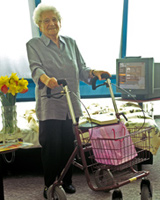E-Health@Home - Business Model for the Apartment as Third Health Location

The necessity to move into a care facility is experienced as a personal stroke of fate that is difficult to cope with. Besides the emotional dimension, assisted living-arrangements always also involve high costs for society - a large problem in today’s aging society.
This is why Fraunhofer ISST, the Competence Center E-Commerce of the Free University of Berlin, the Institute for Labor and Technology (IAT), the Institute for E-Business Security at Ruhr-University Bochum, the University of Applied Science Niederrhein, T-Systems and various cooperating partners started an initiative led by the Rhein-Ruhr Institute for Social Research and Policy Consultation of the University Duisburg-Essen. The project is oriented towards the identification, evaluation, organization and implementation of telemedical services for elderly people on the basis of new business models and in unprecedented quality until the end of the year 2011. The felt quality of life of elderly people is supposed to be increased and the costs for healthcare decreased - the latter not only from the point of view of private of public cost units but also from the perspective of individual patients and their relatives. Therefore, already existing applications from the field of telemedicine and from research in the field of “Ambient Assisted Living” are integrated. Fraunhofer ISST is planning to conceptualize a so called “service-oriented architectural framework”, which can be used to link individual modules and interfaces and which can be customized and made available for the client.
The project is oriented towards people age 65 or older, who live in their own homes. Project partners want to provide technological aids and intelligent building services to spare them the need for costly care services as long as possible in early stages of diverse illnesses or general age-related impairment. The project partners aim to contribute to the improvement of the quality of care and the detection of saving potential.
 Fraunhofer-inHaus-Center
Fraunhofer-inHaus-Center